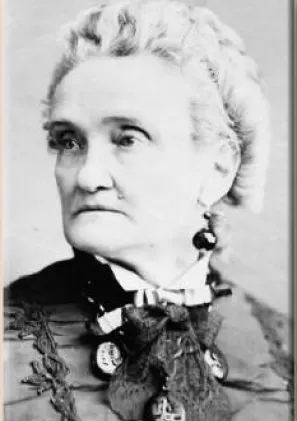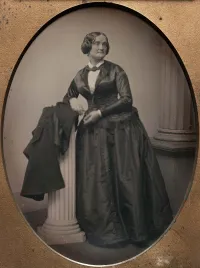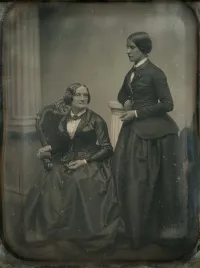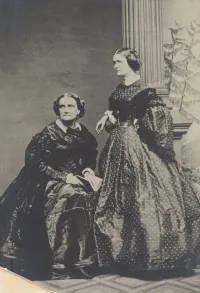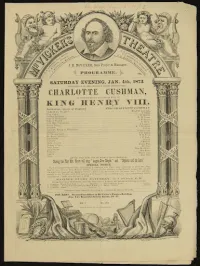Biography
1816 - 1876
“Art is an absolute mistress; she will not be coquetted with or slighted; she requires the most entire self-devotion, and she repays with grand triumphs.”
– Charlotte Cushman
In her early teens Boston-born Charlotte Cushman was relied upon to help support her family. Possessing a full voice, the young girl pursued a career in opera but after only a few years her voice began to fail and she turned to acting. Cushman achieved her first great success as Lady Macbeth in 1835. At 23, she became famous playing Romeo opposite her sister Susan and others playing Juliet. During the next few years, with her career at its peak, Cushman dressed like a man down to her waistcoat offstage and became romantically involved with several women, most notably writer Matilda Hays. In Europe they were publicly known as a couple with poet Elizabeth Barrett Browning describing them as having a female marriage. Performing as almost 190 different female and male characters on stages across the US and Britain, Cushman became one of the most famous women in the English-speaking world and even gave a command performance as Katherine in Henry VIII for Queen Victoria. An early feminist, Cushman demanded wages equal to that of her male counterparts and in 1852 travelled to Rome with Hays and some friends, determined to create a woman centered community stressing female unity and emancipation from men. The relationship with Hays soon soured and Cushman became romantically involved with actress Emma Crow and sculptor Emma Stebbins. Before leaving Italy, she gave a farewell performance in the role of Hamlet and was billed as “a lady universally acknowledged as the greatest living tragic actress.” Returning to New York, Cushman became a celebrated dramatic reader. In 1869, she underwent treatment for breast cancer and seven years later she died of pneumonia at age 59 with Stebbins by her side.
1816 - 1876
“Art is an absolute mistress; she will not be coquetted with or slighted; she requires the most entire self-devotion, and she repays with grand triumphs.”
– Charlotte Cushman
In her early teens Boston-born Charlotte Cushman was relied upon to help support her family. Possessing a full voice, the young girl pursued a career in opera but after only a few years her voice began to fail and she turned to acting. Cushman achieved her first great success as Lady Macbeth in 1835. At 23, she became famous playing Romeo opposite her sister Susan and others playing Juliet. During the next few years, with her career at its peak, Cushman dressed like a man down to her waistcoat offstage and became romantically involved with several women, most notably writer Matilda Hays. In Europe they were publicly known as a couple with poet Elizabeth Barrett Browning describing them as having a female marriage. Performing as almost 190 different female and male characters on stages across the US and Britain, Cushman became one of the most famous women in the English-speaking world and even gave a command performance as Katherine in Henry VIII for Queen Victoria. An early feminist, Cushman demanded wages equal to that of her male counterparts and in 1852 travelled to Rome with Hays and some friends, determined to create a woman centered community stressing female unity and emancipation from men. The relationship with Hays soon soured and Cushman became romantically involved with actress Emma Crow and sculptor Emma Stebbins. Before leaving Italy, she gave a farewell performance in the role of Hamlet and was billed as “a lady universally acknowledged as the greatest living tragic actress.” Returning to New York, Cushman became a celebrated dramatic reader. In 1869, she underwent treatment for breast cancer and seven years later she died of pneumonia at age 59 with Stebbins by her side.
Demography
Demography
Gender Female
Sexual Orientation Lesbian
Gender Identity Cisgender
Ethnicity Caucasian/White
Nations Affiliated United States United Kingdom Italy
Era/Epoch First-wave Feminism (1848-1930) Victorian Era (1837-1901)
Field(s) of Contribution
Theater
Commemorations & Honors
Emma Stebbin’s The Angel of the Waters Statue above the Fountain at Central Park’s Bethesda Terrace Inspired by Cushman
Charlestown Home Site on the Boston Women's Heritage Trail
Charlotte Cushman Foundation Named After Her (1907)
Posthumous Hall of Fame for Great Americans Inductee (1915)
Demography
Gender Female
Sexual Orientation Lesbian
Gender Identity Cisgender
Ethnicity Caucasian/White
Nations Affiliated United States United Kingdom Italy
Era/Epoch First-wave Feminism (1848-1930) Victorian Era (1837-1901)
Field(s) of Contribution
Theater
Commemorations & Honors
Emma Stebbin’s The Angel of the Waters Statue above the Fountain at Central Park’s Bethesda Terrace Inspired by Cushman
Charlestown Home Site on the Boston Women's Heritage Trail
Charlotte Cushman Foundation Named After Her (1907)
Posthumous Hall of Fame for Great Americans Inductee (1915)
Resources
Resources
Crawford, Julie. "Cushman, Charlotte." Lesbian Histories and Cultures. Bonnie Zimmerman, ed. New York: Garland, 2000. 217.
Leach, Joseph. Bright Particular Star: The Life & Times of Charlotte Cushman. New Haven: Yale University Press, 1970.
Merrill, Lisa. When Romeo Was a Woman: Charlotte Cushman and Her Circle of Female Spectators. Ann Arbor: University of Michigan Press, 1999.
Miller, Tim. "Charlotte Cushman, Lesbian Superstar: Tim Miller interviews the author of When Romeo Was a Woman, Lisa Merrill." The Gay & Lesbian Review 7.3 (July 31, 2000): 16-17.
Mullinix, Elizabeth Reitz. "Acting between the Spheres: Charlotte Cushman as Androgyne." Theatre Survey 37 (November 1996): 22-65.
Stebbins, Emma. Charlotte Cushman: Her Letters and Memories of Her Life. 1879. Rpt. New York: Benjamin Blom, 1972.
http://en.wikipedia.org/wiki/Charlotte_Saunders_Cushman
https://outinjersey.net/lgbt-history-charlotte-cushmans-passions-on-stage-and-off/
https://www.folger.edu/shakespeare-unlimited/romeo-charlotte-cushman
https://alpennia.com/blog/lesbian-historic-motif-podcast-episode-19d-charlotte-cushman
http://www.homohistory.com/2013/02/the-many-loves-of-charlotte-cushman.html
http://historicheroines.org/2015/08/01/charlotte-cushman-not-your-average-romeo/
https://www.smithsonianmag.com/smithsonian-institution/the-rise-and-fal…Resources
Crawford, Julie. "Cushman, Charlotte." Lesbian Histories and Cultures. Bonnie Zimmerman, ed. New York: Garland, 2000. 217.
Leach, Joseph. Bright Particular Star: The Life & Times of Charlotte Cushman. New Haven: Yale University Press, 1970.
Merrill, Lisa. When Romeo Was a Woman: Charlotte Cushman and Her Circle of Female Spectators. Ann Arbor: University of Michigan Press, 1999.
Miller, Tim. "Charlotte Cushman, Lesbian Superstar: Tim Miller interviews the author of When Romeo Was a Woman, Lisa Merrill." The Gay & Lesbian Review 7.3 (July 31, 2000): 16-17.
Mullinix, Elizabeth Reitz. "Acting between the Spheres: Charlotte Cushman as Androgyne." Theatre Survey 37 (November 1996): 22-65.
Stebbins, Emma. Charlotte Cushman: Her Letters and Memories of Her Life. 1879. Rpt. New York: Benjamin Blom, 1972.
http://en.wikipedia.org/wiki/Charlotte_Saunders_Cushman
https://outinjersey.net/lgbt-history-charlotte-cushmans-passions-on-stage-and-off/
https://www.folger.edu/shakespeare-unlimited/romeo-charlotte-cushman
https://alpennia.com/blog/lesbian-historic-motif-podcast-episode-19d-charlotte-cushman
http://www.homohistory.com/2013/02/the-many-loves-of-charlotte-cushman.html
http://historicheroines.org/2015/08/01/charlotte-cushman-not-your-average-romeo/
https://www.smithsonianmag.com/smithsonian-institution/the-rise-and-fal…